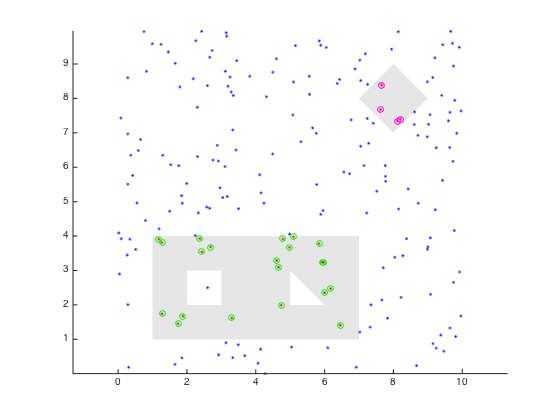inpolygons
inpolygons.m Documentation
This function checks whether a point or points is inside one or more polygons. The polygons can have holes in them. When dealing with a large number of points and/or polygons, this can be faster that inpolygon.m.
Syntax
in = inpolygons(x,y,xv,yv)
[in, index] = inpolygons(x,y,xv,yv)
See function help for description of input and output variables.
Example
We'll start with two polygons: a rectangle with square- and triangle-shaped holes, and a solid diamond:
xv = [1 1 7 7 1 NaN 2 3 3 2 2 NaN 5 6 5 5 NaN 7 8 9 8 7];
yv = [1 4 4 1 1 NaN 2 2 3 3 2 NaN 2 2 3 2 NaN 8 9 8 7 8];
[f, v] = poly2fv(xv, yv);
patch('Faces', f, 'Vertices', v, ...
'FaceColor', [.9 .9 .9], ...
'EdgeColor', 'none');Now, we scatter a couple hundred random points, and test which polygons they fall into.
x = 10 * rand(200,1);
y = 10 * rand(200,1);
[in, index] = inpolygons(x, y, xv, yv);
index = cell2mat(index); % No overlapping polygons allows this.
plot(x(in), y(in), 'r.', x(~in), y(~in), 'b.');
plot(x(index==1), y(index==1), 'go', x(index==2), y(index==2), 'mo');Zitieren als
Kelly Kearney (2025). inpolygons (https://github.com/kakearney/inpolygons-pkg), GitHub. Abgerufen.
Kompatibilität der MATLAB-Version
Plattform-Kompatibilität
Windows macOS LinuxKategorien
- Mathematics and Optimization > Mapping Toolbox > Data Analysis >
- Radar > Mapping Toolbox > Data Analysis >
Tags
Community Treasure Hunt
Find the treasures in MATLAB Central and discover how the community can help you!
Start Hunting!Live Editor erkunden
Erstellen Sie Skripte mit Code, Ausgabe und formatiertem Text in einem einzigen ausführbaren Dokument.
inpolygons
Versionen, die den GitHub-Standardzweig verwenden, können nicht heruntergeladen werden
| Version | Veröffentlicht | Versionshinweise | |
|---|---|---|---|
| 1.1.0.1 | linked GitHub readme |
|
|
| 1.1.0.0 | Linked to GitHub repository |
|
|
| 1.0.0.0 |





